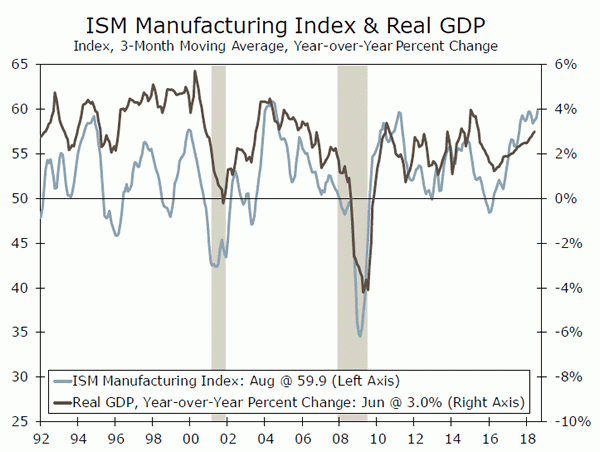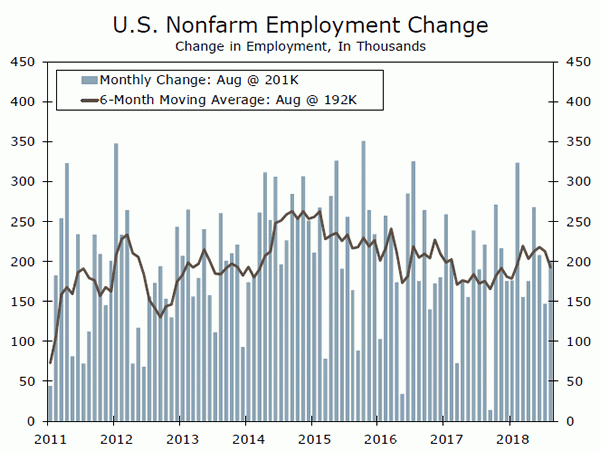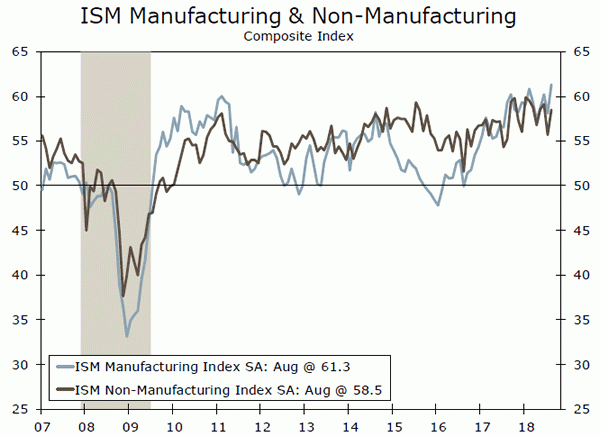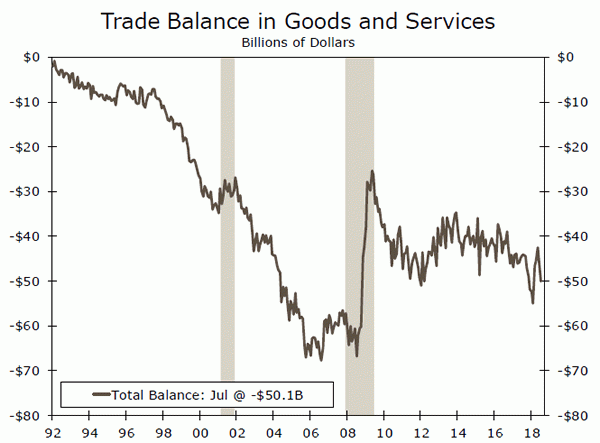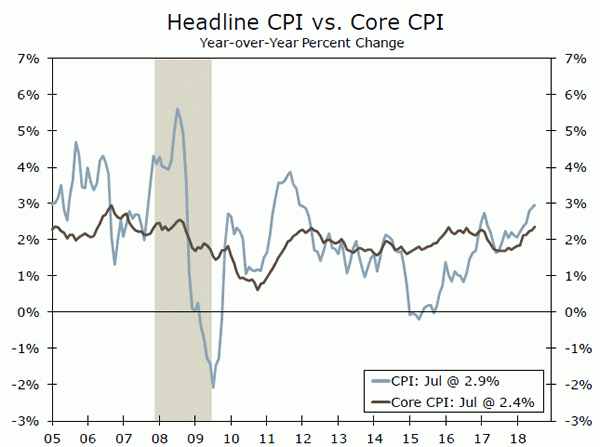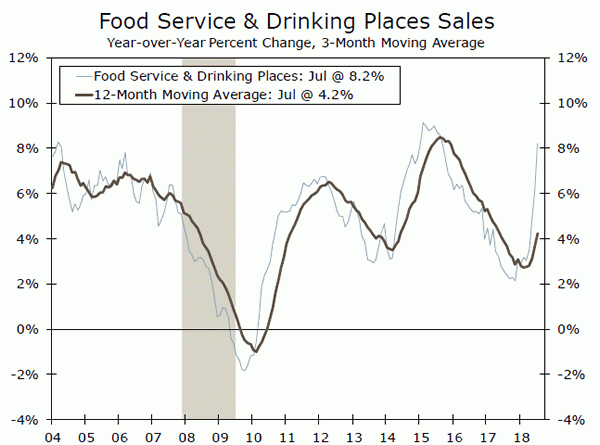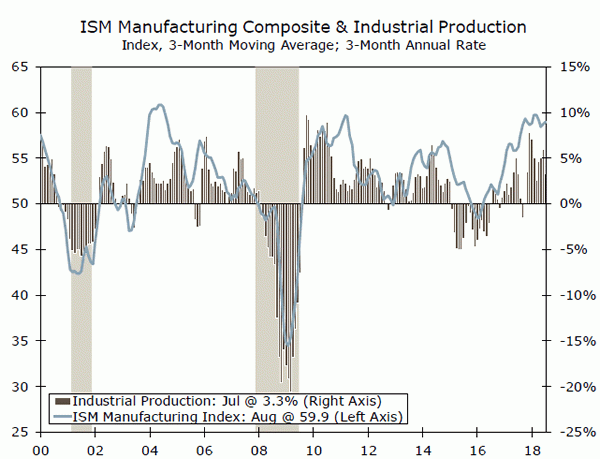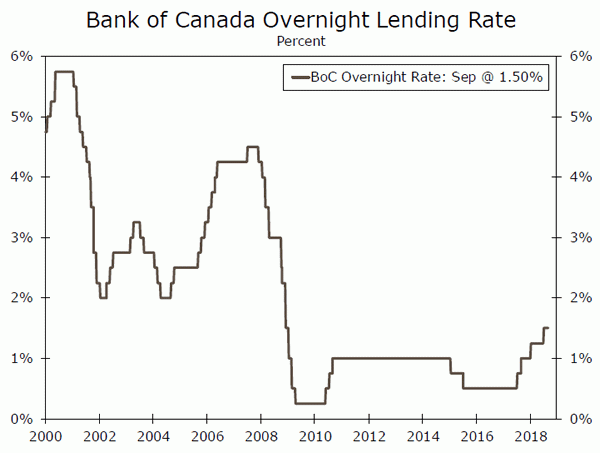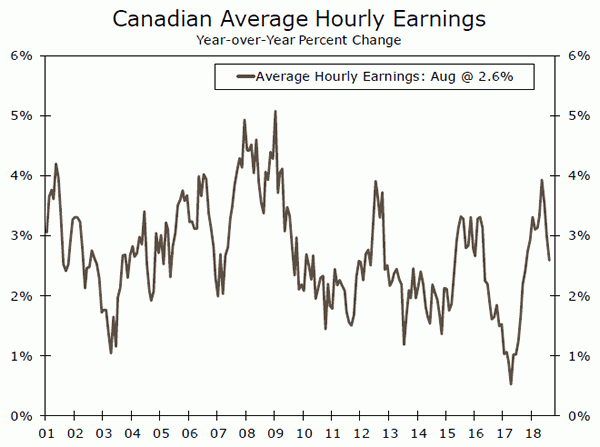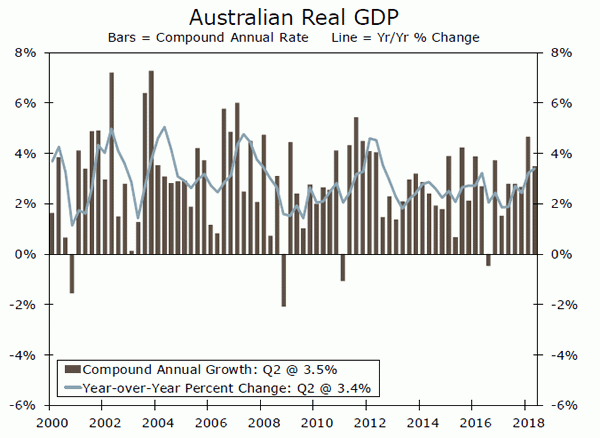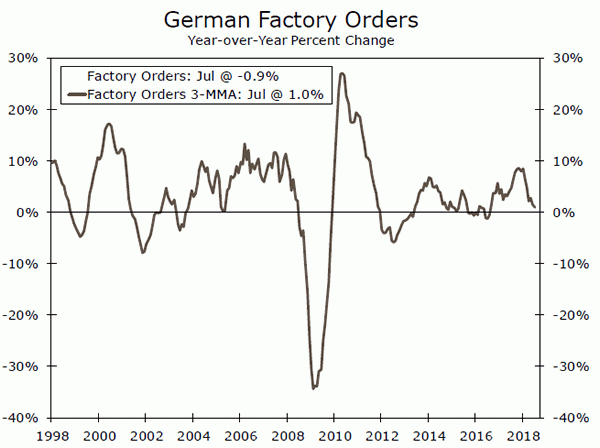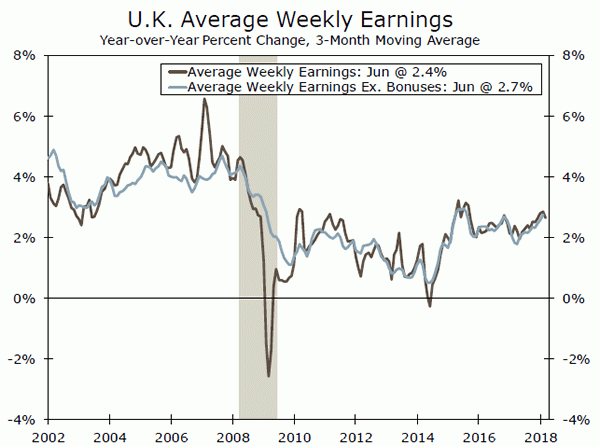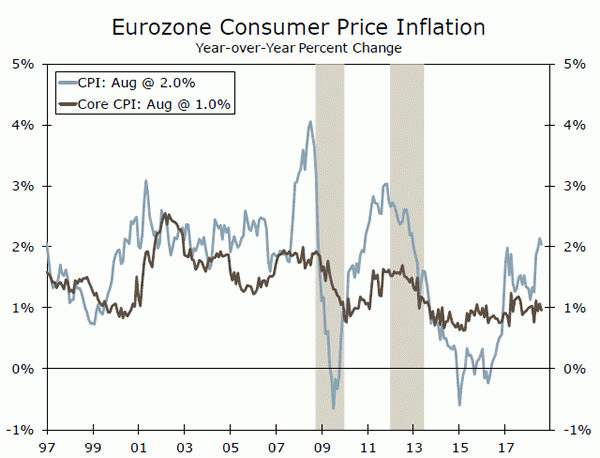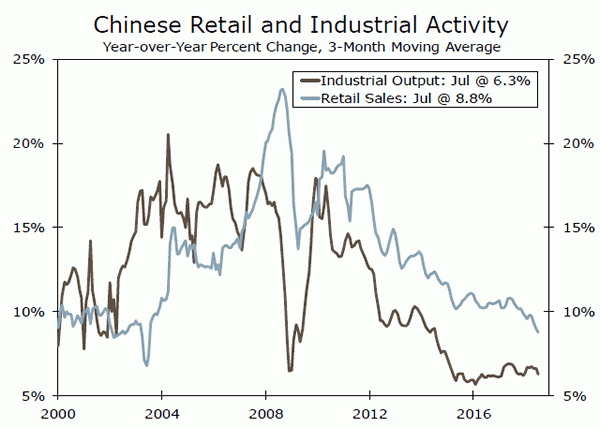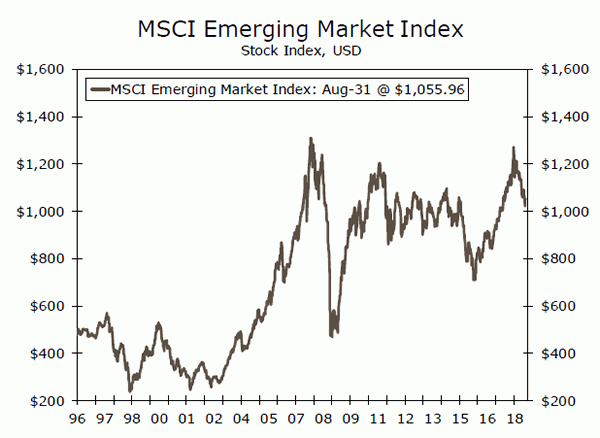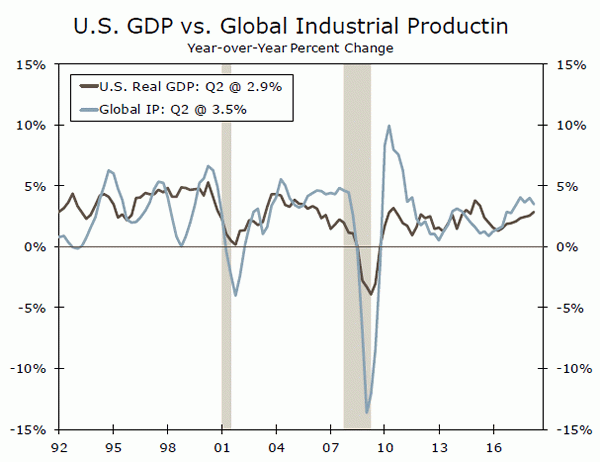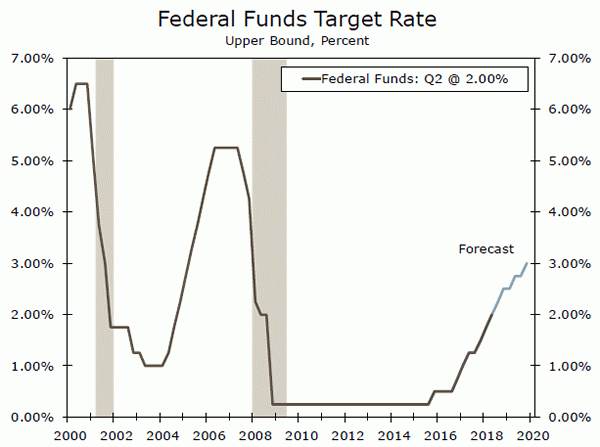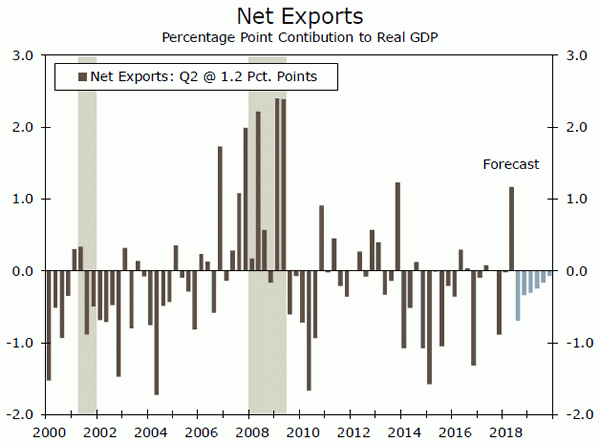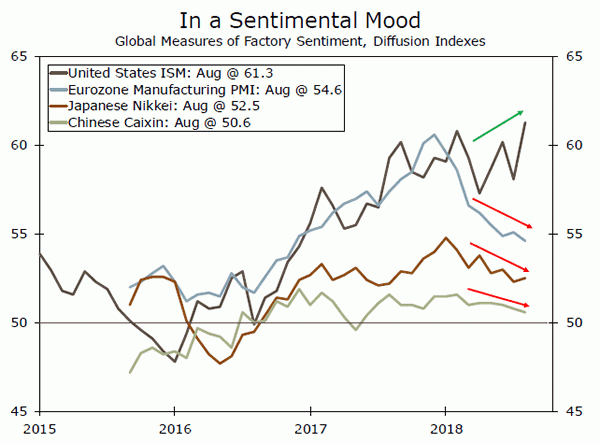U.S. Review
Economy Appears Solid Despite Trade Tensions
- Despite ongoing concerns surrounding trade policy, business activity reportedly picked up in August. The ISM manufacturing and non-manufacturing indices both advanced, increasing to 61.3 and 58.5, respectively.
- Employers added 201,000 new jobs in August. The unemployment rate was unchanged at 3.9%. Average hourly earnings are now up 2.9% year-over-year, a new cycle high.
- The trade deficit rose to $50.1 billion in July as exports dropped 1.0%. In contrast to the substantial contribution in Q2, we expect trade to weigh on GDP growth in coming quarters.
Economy Appears Solid Despite Trade Tensions
Evidence continued to mount this week that economic growth is poised to remain solid in the third quarter. Trade tensions continue to escalate, and consecutive drops in exports in June and July will likely lead to a reversal of trade’s second quarter boost to overall GDP growth. However, overall business activity reportedly remains strong, as both the ISM manufacturing and nonmanufacturing indices advanced higher in August. The labor market also continued to improve and employers continue to add jobs across a wide array of industries.
Employers added 201,000 new jobs in August. The prior two months of additions were revised down 50,000, bringing the three-month average to 185,000. Gains in August were broadbased, with most industries adding jobs over the month, notably the transportation and warehousing & construction sectors. Manufacturing jobs fell slightly during the month. The unemployment rate was unchanged at 3.9%; however, the labor force participation rate dropped to 62.7%. Meanwhile, wage growth continues to trend higher. Average hourly earnings increased 0.4% for the month and 2.9% on a year-over-year basis, a new cycle high.
Manufacturing activity appeared unscathed by trade tensions in August. The ISM manufacturing index hit 61.3, the highest reading in 14 years. Both the current production and new orders indices posted large increases during the month. The prices paid component eased somewhat, but remained elevated at a still-high 72.1. Tariffs were mentioned by several respondents who noted suppliers were able to pass on tariff-related price increases. Meanwhile, capacity constraints tightened as supplier delivery times and order backlogs increased.
Outside of the factory sector, firms also reported a positive assessment. The ISM non-manufacturing index topped expectations and jumped 2.8 points to a 58.5 reading in August. The current activity, new orders and backlog sub-indices each edged higher during the month, indicating that the pick-up in activity was broad-based. The prices paid index eased, but remained high at 62.8.
Meanwhile, the surge in exports in the second quarter as some businesses rushed to get merchandise out the door ahead of retaliatory tariffs will likely be reversed in the third quarter. Total exports fell 1.0% in July, bringing the trade deficit to $50.1 billion. The dip in exports follows a 0.7% drop in June. The consumer goods, capital goods and food & beverage categories also saw significant gains in May only to be followed by back-to-back declines in June and July. Meanwhile, strong consumer spending and business investment continued to support demand for imports, which increased 0.9% in July. Gains were broad-based with imports increasing in five out of six major categories. Net exports are poised to be a drag on overall GDP growth in the third quarter, and even if the tariff fight were to be settled, trade is not expected to be a significant driver of growth in coming years.
U.S. Outlook
CPI • Thursday
The headline CPI rose 0.2% in July, putting the year-over-year increase at 2.9% for the fastest pace in six years. While a drop in energy prices caused a smaller rise in overall inflation, core inflation rose 2.4% year-over-year to reach a new cycle high. The July surge in core inflation was led by a continued increase in services prices, along with a pickup in airfares and prices for new and used autos. Although rising energy prices have been a key factor behind rising inflation in recent months, we look for energy prices to moderate going forward. While higher inflation has restrained real wage growth over the past year, lower energy prices should give consumers some relief in the coming months, and a continued tight labor market should also support wage growth. Given the steady rise in core CPI that has kept track with the pace of PCE inflation, it looks to be full steam ahead for the FOMC to raise rates twice more this year, and we look for core inflation to continue to firm into 2019.
Previous: 2.9% Wells Fargo: 2.7% Consensus: 2.8% (Year-over-Year)
Retail Sales • Friday
Retail sales rose a solid 0.5% in July, supported by broad-based strength in multiple sectors. Both non-store retailers and traditional retailers posted steady increases in the month. Non-store retail sales has been one of the fastest-growing categories over the past year, with the 8.7% year-over-year gain second only to gas station sales. Consumers also continued the trend of eating out in July, with food service and drinking places sales rising 1.3%, more than twice the increase for traditional grocery and liquor store sales. Auto sales also rose in July, possibly due to preemptive purchases in response to threatened auto tariffs that could push up prices if put into effect.
While the Q2 GDP revision released last week showed that consumer spending rose a strong 3.8% annualized in Q2, rising consumer price inflation could restrain the more rapid pace of real consumer spending seen in recent months. In the near term, we look for retail sales to rise 0.5% in August.
Previous: 0.5% Wells Fargo: 0.5% Consensus: 0.5% (Month-over-Month)
Industrial Production • Friday
Industrial production rose a lower-than-expected 0.1% in July, as the utilities and mining sectors each posted declines. Manufacturing production increased a stronger 0.3%, supported by rising auto and machinery output. There is also some evidence that the steel and aluminum tariffs implemented earlier this year are affecting output in those industries, with iron and steel production up over 7% from a year ago. Overall capacity utilization also continued to rise in July, and signals rising price pressures in the manufacturing sector. The ISM report released earlier this week also offers clues into the state of the manufacturing sector in August. The overall ISM index reached a 14-year high of 61.3, suggesting that manufacturing activity held strong even amid trade concerns. However, the prices paid component remained above 70 for the eighth consecutive month, and we look for tighter capacity and higher prices to restrain production growth in coming months.
Previous: 0.1% Wells Fargo: 0.3% Consensus: 0.3% (Month-over-Month)
Global Review
Emerging Market Concerns Ease
- Fears around emerging market contagion eased this week, allowing the focus to shift back to global central bank developments and economic data releases.
- The Bank of Canada held policy steady this week but signaled a possible acceleration in the pace of rate hikes, although Canada’s jobs report was disappointing.
- On the policy front, Brexit negotiations showed tentative signs of making progress, although a preliminary deal remains elusive for now. Meanwhile, markets remain on edge around global trade tensions, with concerns Japan may be the next target for U.S. tariffs.
Emerging Market Concerns Ease
Sentiment around the global economic outlook started off the week on a sour note, with concerns around emerging markets carrying over from the week prior. While Argentina was a source of concern last week, focus shifted to South Africa this week as data showed that country’s economy unexpectedly slipped into recession in Q2 as real GDP declined 0.7% on a sequential annualized basis. That said, those emerging market concerns dissipated as the week went on, and focus eventually shifted back to central banks and data releases in developed markets.
First, the Bank of Canada (BoC) held its overnight rate at 1.50% as expected, but said it was watching NAFTA progress closely. In later comments, BoC Deputy Governor Wilkins suggested the central bank debated whether to accelerate the pace of rate increases. That guidance is a reminder that Canada’s central bank is among the most active major central banks in normalizing monetary policy, having already raised rates 100 bps since mid-2017. However, data released this week showed Canadian employment unexpectedly fell 51,600 in August, while wage growth slowed to 2.6% year-overyear. Elsewhere, Sweden’s central bank also met this week and made no change to policy but provided more dovish signals, as it suggested it could raise interest rates in either December or February. Previously, the central bank had said it would raise rates sometime later this year, with the latest guidance suggesting a more cautious approach.
Australia’s central bank also met this week, and while it held policy steady and suggested rate increases were unlikely for quite some time, it also acknowledged the recent strengthening in Australian economic growth. Indeed, data released earlier this week showed real GDP rose 3.4% year-over-year in Q2. That represents the quickest annual growth rate since 2012, but with inflation stuck near the bottom of the central bank’s target range, there seems to be no urgency to raise interest rates anytime soon.
The European region also drew some market attention this week. Eurozone data for July were generally subdued, as German factory orders unexpectedly declined 0.9% and Eurozone retail sales fell 0.2% over the month. Meanwhile, in the United Kingdom, sentiment data were mixed as the manufacturing PMI softened to 52.8 in August but the services PMI was stronger than expected, rising to 54.3. Separately, comments from E.U. and U.K. negotiators suggested tentative, albeit gradual, progress toward reaching a preliminary Brexit deal ahead of the March 2019 deadline.
Elsewhere on the policy front, concerns continued to linger around the ongoing global trade tensions. After the public comment period ended this week for the U.S. proposed tariffs on $200 billion of Chinese goods, there appear to be concerns that the U.S. administration may move forward with at least a portion of those proposed tariffs before long. Meanwhile, U.S. President Trump hinted that Japan could become a focus for new trade measures, a sign that global trade tensions could not only persist but also become more broadly based.
Global Outlook
U.K. Labor Market Report • Tuesday
Next week is a busy one for the U.K. economy, with a number of key data releases followed by a policy announcement from the Bank of England (BoE). Among the key releases will be industrial output figures, which will likely be closely watched for any clues that Brexit uncertainty is affecting manufacturing sentiment. Meanwhile, the labor market report is also scheduled for release next week, and the wage figures will likely be the key focus of that report for markets. U.K. wage growth has been fairly steady in recent months, but slowing inflation has eased some pressure on U.K. consumers.
As for the BoE, which is scheduled to announce policy on Thursday of next week, we do not expect many new developments. The BoE raised its Bank Rate 25 bps to 0.75% at its August meeting, and further increases seem unlikely to be considered unless or until Brexit uncertainty is resolved.
Previous: 2.4% Consensus: 2.5% (Average Weekly Earnings, Year/Year)
European Central Bank Meeting • Thursday
The European Central Bank (ECB) has been unwavering in its policy guidance since June, when it signaled it would end asset purchases by December but that it would likely keep interest rates steady until after summer 2019. A combination of soft European economic data, concerns around Italy and ongoing trade tensions have all conspired to keep ECB guidance fairly cautious, while still-subdued Eurozone core inflation has reduced the need for near-term policy normalization.
In our view, the ECB is unlikely to provide many new signals at its policy announcement next week, particularly given ongoing concerns around Italy and global trade. Instead, we believe it is more important to monitor the incoming European data flow for clues on whether the ECB might deviate from the policy schedule it laid out at its June announcement.
Previous: -0.40% Wells Fargo: -0.40% Consensus: -0.40% (Deposit Rate)
China Retail Sales • Friday
The Chinese economy has been a key focus for markets in recent months as U.S.-China trade tensions have simmered. Chinese growth and activity figures have softened over the past few months, with retail sales in particular showing signs of slowing. Authorities have taken steps to ease monetary and fiscal policy in an effort to cushion the slowdown, including cuts to the reserve requirement ratio for the country’s banks.
Next week’s release of Chinese retail sales figures will be important to monitor, particularly for any clues whether recent policy easing measures are starting to cushion the slowdown in economic activity. Also due for release are industrial output and fixed investment figures, as well as monetary indicators, which will provide some insight into how the recent policy measures from Chinese authorities are affecting the amount of liquidity in the economy.
Previous: 8.8% Consensus: 8.8% (Year-over-Year)
Point of View
Interest Rate Watch
EM Turmoil Through a Fed Lens
Emerging market (EM) risks were back in the spotlight this week. In contrast to earlier this year, when turmoil was centered on a few select countries, emerging market currencies were broadly under pressure and the MSCI Emerging Market Index neared bear market territory (top chart).
Could current tightening in EM conditions derail the Fed’s plans to further tighten policy? Rising U.S. rates are thought to be negative for emerging market capital flows as investors can receive relatively more reward for less risk. Sudden outflows can weaken growth as central banks are forced to raise interest rates to stem the tide. If significant enough, slower growth in EM and a strengthening in the dollar as inflows reverse could weigh on U.S. growth.
“The Role of U.S. Monetary Policy Is Often Exaggerated” – Jerome Powell
Fed officials have shown little concern about the state of emerging markets. EM capital flows received only a passing mention at the most recent FOMC meeting, with Fed staff noting outflows had slowed in recent weeks.
Moreover, Fed Chair Powell gave a speech in May about how the linkages between U.S. monetary policy and global financial conditions were frequently overstated. While monetary policy in the United States (and other advanced economies) influences EM capital flows, the growth differentials that underlie policy decisions and commodity prices also play important roles.
The EM turmoil of the late 1990s suggests conditions would need to worsen significantly to invoke a policy response by the Fed. U.S. growth barely budged over that period even as global growth, proxied by industrial production, slowed sharply (middle chart). It was not until nearly a year after EM stock markets entered bear territory and the dollar had risen roughly 10% before the Fed made a rate cut.
Moreover, as we have discussed in recent reports, on net, finances across EM are in generally better shape today than they were in the late 1990s. As a result, we do not see the recent turmoil as altering the Fed’s current policy path, and still expect the FOMC to raise rates twice more this year (bottom chart).
Credit Market Insights
Down Trend in Small Business Loans
Small business loans have been steadily shrinking as a share of total business loans. According to the Federal Deposit Insurance Corporation (FDIC), loans under $1 million represented 20% of commercial & industrial and nonfarm nonresidential loan balances in Q2, matching record lows.
Part of the decline in small business loans can be attributed to inflation, since small loans are classified by the FDIC using nominal dollars. However, inflation alone cannot account for the magnitude of the recent decline. At the peak of the previous economic expansion in 2007, small loans made up 30% of commercial & industrial and 39% of nonfarm nonresidential loans.
Post-financial crisis, small loans declined more in percentage terms than larger ones. While total commercial and industrial loan balances grew 5% from 2011 to 2007, small loans declined 13%. The divergence is even starker for nonfarm nonresidential loans, where small loan balances have shrunk every year since 2009 but total balances returned to positive growth in 2012.
A number of reasons could be behind these trends. Banks have become more cautious lenders since the crisis, and small businesses tend to have shorter credit histories and less access to collateral than more established businesses. In addition, increased availability of financing from non-bank lenders, which tend to have easier lending standards, and healthier profits are likely weighing on demand for small loans from banks.
Topic of the Week
Duke Ellington Economics
While the jobs report and confirmation hearings for the Supreme Court dominated the news cycle this week, some less-widely followed details emerged that offer fresh perspective on the emerging trade conflict.
The ISM manufacturing index jumped to 61.3—its highest level since 2004 when the index was just a tick higher at 61.4, and the second-highest level since 1984.
This euphoria is difficult to square with some of the regional Fed surveys which, while still high, have rolled over in recent months. Aside from the fact that the export orders component slipped for the fourth time in five months, it is difficult to see how the tariff fights are hurting activity in this bellwether for the factory sector.
Mood Indigo
When you check in on the sentimental mood of overseas manufacturers you find a different story. In the top chart, we have plotted the U.S. ISM index against a few of its counterpart measures. Since the tariff talk ramped up this spring, the U.S. measure continued a trend ascent, even as the Japanese Nikkei PMI and Chinese Caixin index both edged lower. In the Eurozone, manufacturers report the slowest pace of expansion since the end of 2016 with the Eurozone PMI having slipped to 54.6.
In My Solitude
How long can the U.S. factory sector continue to go-italone and defy the gravity that has pulled down manufacturing sentiment overseas? That remains to be seen, but after trade boosted growth in the second quarter, it is poised to weigh on growth in Q3. We learned this week for example that exports in July fell for the second straight month, down another 1.0% with a drop on the goods side swamping a scant pick-up in service exports. As the retaliatory tariffs start to bite, we expect that some of the initial enthusiasm with which the tariffs have been met so far will fade as businesses come to terms with the many hard-to-predict ways that protectionist measures can impact global supply chains.




